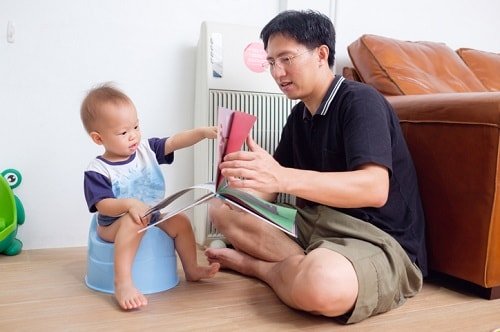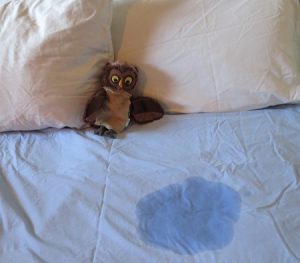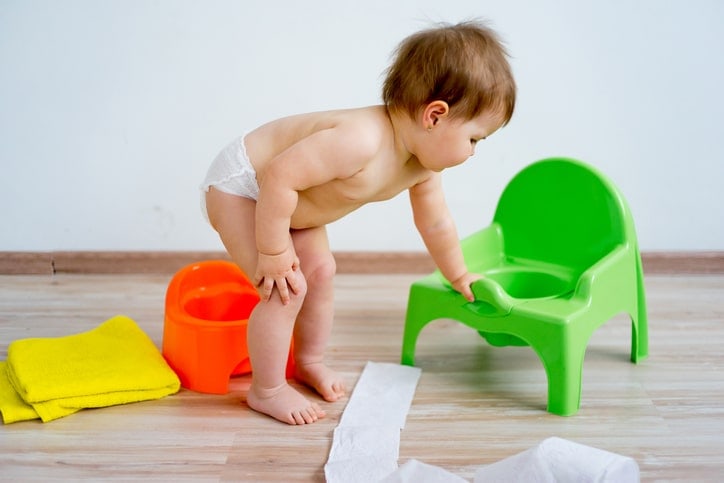Common potty training problems include anxiety, refusal to use the potty, and attempts to delay or avoid defecation. In addition, it’s common for kids to have daytime accidents and wet the bed. Children may also feel reluctant to use toilet facilities when they are away from home.
What can we do about these problems? If we plan ahead, we can prevent many of them from arising in the first place. At the end of this article, I offer tips for avoiding trouble.
But first, let’s consider what you can do if you’ve already hit a stumbling block. Here’s an evidence-based guide to coping with common potty training problems.

1. Solving potty training problems caused by anxiety
When children refuse to cooperate, it might seem that they’re being lazy or unreasonable. But some kids suffer from understandable anxieties about toilet training (Baird et al 2019).
Sometimes it’s simply the fear of something new. The potty chair is unfamiliar; so is the routine. Sometimes children have specific fears about toilets. They might be frightened by the noises that toilets make, or by the mysterious way that flushed items vanish. They might fear falling into the toilet, or worry that something — a creature or monster — lurks inside.
And many kids have had experiences — with constipation, urinary tract infections, or other medical problems — that have made them associate toileting with pain.
Whatever the reason for a child’s trepidation, being forced or pushed into toilet training doesn’t help. Nobody likes to be coerced and frog-marched through a mysterious procedure! Young children need to know what to expect. They need to learn that there is nothing to fear.
So if your child shows signs of anxiety about toilet training, the first order of business is to reduce that anxiety.
Before you do anything else, make sure your child isn’t suffering from constipation, hard stools, or any other potentially painful condition. And even if you see no signs of medical trouble, it’s helpful to review your child’s diet and fluid intake. Make sure your child is drinking enough water, and consuming a high-fiber diet.
Then take the time to help you child learn: Teach your child what to expect, and allow your child the opportunity to investigate and ask questions.
Let your child get used to the potty chair by leaving it out in a place where your child plays. Defuse potential fears by explaining how things work. For example, show how your child how the toilet works, and reassure him or her that there is nothing to fear.
As your child becomes more relaxed, try introducing a series of practice “potty sits,” where your child stays seated on the potty for a short time.
For the first few practice sits, your child may remain fully clothed, and sit for only 30 seconds or so. Praise your child for cooperating. As your child becomes more accepting of the process, you can have your child practice bare-bottomed, and gradually lengthen the sessions.
Once you’ve overcome your child’s fears, your child will be ready to resume toilet training. See this article for a discussion of different potty training techniques.
2. What to do when kids refuse to sit
Sometimes kids flat-out refuse to sit on a potty chair or toilet. What then?
First, make sure your child has stability and leverage when he or she sits.
When children’s feet are left dangling, kids aren’t merely less comfortable. They also have more trouble controlling their voiding muscles (Christophersen 1991). For this reason, researchers advise that toilet training is best accomplished using a child-sized potty. To use a toilet, place a child’s training seat on top, and place a short stool under your child’s feet.
Second, consider your child’s psychological readiness. Is there something more your child needs to learn before pushing ahead?

Pediatricians, like those of the Canadian Paediatric Society, argue that refusal is a sign that your child isn’t ready for training. They recommend that you take a break from potty training for a month or two, and try again.
This isn’t unreasonable advice. Trying to force toilet training on an unwilling child is a bad idea. Children may respond by trying to withhold urine or stool, increasing the risk of a urinary tract infection or constipation. A coercive approach could also increase your child’s anxieties and fears — causing more potty training problems (Schmidt 2004b).
How can you know if your child is psychologically ready to start training? Experts have suggested many different signs. Three may be especially useful in predicting whether or not your child has the skills needed to successfully complete training (Wyndaele et al 2020):
- The child shows an awareness about and communicates the need to urinate or defecate;
- The child can pull his or her pants up and down;
- The child is interested in doing things for him- or herself, and shows pride in new skills .
You can read more about this in my article, “Signs of toilet training readiness.” But, as I note there, you don’t have to simply wait it out if you decide your child ready. Instead, use the time to familiarize your child with the steps people take when they need to use the toilet.
Address any fears or anxieties your child might have (see #1). Read picture books about the process, stage demonstrations, and model a positive attitude. Then, as your child’s resistance fades, you can introduce the practice sits mentioned above (#1). And don’t leave children to sit alone, bored, with nothing to do. Provide them with companionship and diversions, and consider the use of rewards (such giving kids stickers for each of their toilet sessions).
For more ideas about preparing your child for toilet training, read these evidence-based tips.
3. Coping with kids who won’t defecate
Your child is willing to urinate in a potty or toilet, but refuses to have a bowel movement. What’s going on?
Experts call this “stool toileting refusal,” and research suggests it’s linked with constipation and painful bowel movements (Blum et al 2004; Kimball 2016; Baird et al 2019). For example, in a study tracking 380 American toddlers, one in four children developed stool toileting refusal, and in most cases the problem was preceded by constipation. In fact, kids who had experienced frequent, hard bowel movements were more than twice as likely to suffer from stool toileting refusal (Blum et al 2004).
So if you’re coping with stool toileting refusal, it makes sense to take special care with your child’s diet and fluid intake, and discuss the problem with your pediatrician.
If you can make it easier for your child to pass a bowel movement, your child’s potty training problems may soon resolve (Kuhn et al 1999). And there is evidence that an upbeat, encouraging manner can help, too.
In study of more than 400 young children, half the parents were randomly assigned to take this approach — praising babies for defecating, and avoiding the use of negative terms for feces.
The approach didn’t prevent stool toileting refusal, but it shortened the time it took for children to grow out of it (Taubman et al 2003). So it seems a good idea to monitor the way you communicate with your child, and avoid sending the message that defecation is disgusting or shameful.
4. What to do if you suspect your child is holding back urine
This problem isn’t very common, not like stool toileting refusal. But some children do show reluctance to urinate during the toilet training process, and we definitely want to prevent this from becoming a habit. Prolonged urine retention stretches the bladder, and puts kids at higher risk for urinary tract infections and other problems. What should we do about it?
First, if you suspect your toddler is holding his or her pee, make sure you are following the advice already mentioned regarding anxiety, encouragement, praise, and other incentives.
Second, talk with your pediatrician about your concerns, especially if you are observing signs of discomfort, or a need to strain or concentate in order to initiate and maintain a stream.
Urinary tract infections and constipation can both play a role in urine retention. In addition, some kids experience urine retention due to unusual physiological factors, like an overly narrow urethra. Your medical provider can help identify these problems, or rule them out.
Third, you can try this trick, which has proven effective for otherwise healthy toddlers who aren’t urinating on the potty: Expose your child to the the sounds and sensations of water. People of all ages may be susceptible to the “running water effect”: When we hear the sound of trickling water, it facilitates urination (e.g., Kwon et al 2015).
So, during a “potty sit”, try running the tap water in the bathroom sink, or having your child swish his or her feet around in a basin of warm water. Alternatively, you could try a related technique that’s been tested on adults — playing back a recording of trickling water (Kwon et al 2015).
And when your child does urinate, encourage him or her to keep at it until the bladder feels totally empty. And keep holding regular, frequent potty sessions throughout the day. According to a recent study, more than 70% of children under the age of 4 years urinate at least 3 times per day. Among younger kids, the percentage is even higher (Verkuijl et al 2023).
But this doesn’t mean that you should aim for the bare minimum of potty sessions. On the contrary, experts typically recommend seating toddlers on their potties every 1-2 hours, and even sooner if a child has recently consumed a large drink or eaten.
5. Overcoming resistance to using toilets when your child is away from home
Even adults can be reluctant to use a public lavatory, so it shouldn’t be hard to empathize. The simplest solution is to use a portable child’s toilet seat — the kind that can be fitted over the top of a standard toilet. Practice with it at home, and bring it with you when you travel.
6. Understanding daytime accidents and wetting the bed

It’s important to be realistic. Accidents are very common throughout the toilet training process! In fact, even after you’ve finished toilet training, you should expect the occasional mishap.
In a study tracking American children, researchers defined potty training as completed when parents reported “less than 4 urine accidents per week and 2 or fewer episodes of fecal soiling per month” (Blum et al 2003).
That’s progress, but it’s far from perfection. And the younger your child is, the more difficult it’s going to be to avoid accidents.
In a study tracking the development of approximately 60 Swedish children, researchers found that only 31% of 2-year-olds were reported to have good bladder sensation. By contrast, bladder sensation was reported in 79% of 3-year-olds (Janssen et al 2005).
These researchers also found hints that bladder capacity matters. Children who developed larger bladder capacity at an earlier age tended to achieve daytime dryness sooner (Janssen et al 2005).
So your child’s rate of accidents is going to depend on his or her age, as well as individual developmental factors. To minimize accidents, the best approach is to monitor to your child’s fluid intake, and add some well-timed potty sits to your child’s schedule.
What about night? To stay dry at night, the bladder needs to receive a hormonal signal to produce less urine. Sleepers also need to have good bladder sensation, and then awaken when their bladders feel full.
Young children may face special challenges on all of these fronts: These abilities are still developing during early childhood. As a result, many kids don’t reach the milestone of nighttime dryness until they are 4 or 5 years old (Fergusson et al 1986).
For example, in the Swedish study just mentioned, only half the children had achieved nighttime dryness by the age of 4 (Janssen et al 2005).
So for young children, bed-wetting isn’t a potty training problem as much as it is a developmental phase. Reducing fluids before bedtime can help, but it won’t eliminate nighttime accidents — not unless your child has developed mature bladder function. If your child is still wetting the bed at the age of 5, doctors are more likely to view this as evidence of a problem (Kessel et al 2017). Read more about bed-wetting here.
Being proactive: 10 tips for preventing future potty training problems
To prevent future mishaps and health problems, here is some additional advice.

1. Actively prepare your child for potty training
As noted in the introduction, you can avoid some potty training problems by planning ahead. See this evidence-based article for an overview of how to make it easier for your child to adjust.
2. Avoid direct confrontations. Don’t force your child to sit, or restrain your child when he or she wants to get up.
Your child cooperated yesterday, but suddenly resists your request to use the potty. What should you do? Experts say it’s better to back off and try again later. Coercion can lead to all sorts of problems, including constipation, urinary tract disorders and phobias (Schmidt 2004b).
3. Don’t let kids feel lonely or bored.
Try to make time on the potty more interesting by talking with your child, reading stories, or providing your child with games and toys.
4. Don’t punish or scold your child for accidents.
When children are subjected to punishment or scolding, they may start holding back their urine or stool — putting them at higher risk for urinary tract infections, constipation, and stool toileting refusal (Schmidt 2004b).
5. Avoid potty chairs with splash guards.
Boys can catch their genitals on them when they are moving on or off the potty. If you teach your son to pee sitting down, show him how to hold his penis down so the urine goes into the potty. If your son prefers to stand, let him pee in a bucket (Schmidt 2004a).
6. Take steps to prevent constipation.
We’ve already mentioned this, but it bears repeating: Constipation increases a child’s risk for developing potty training problems (Taubman 1997; Blum et al 2004). Make sure your child drinks plenty of fluids (at least four cups a day) and consumes plenty of fiber (Sears et al 2002). If your child has a chronic constipation problem, consult your doctor.
7. Beware of bubble baths and soapy bathwater.
The soap can cause an inflammation of the urethra, which makes urination painful. Girls are more likely to develop this problem than are boys.
8. Don’t encourage your child to strain
Straining can cause disorders of the bladder and sphincter muscles (Weiner et al 2000). If your child can’t urinate without straining, report this to your pediatrician.
9. Consider scheduling a few routine potty visits during the day
Some pediatricians (Brazelton and Sparrow 2004) recommend that all potty sessions be child-initiated (no prompting from parents).
However, this approach is a matter of personal preference. Another approach features regularly scheduled potty sessions, such as immediately after waking, after meals, and before bedtime. When potty sessions are treated as a part of the daily routine, kids learn to expect them without being nagged (Lekovic 2006). Scheduled potty sessions may also have health benefits, including the prevention of urinary tract infections (Bakker 2002).
10. Help your child wipe
Most children don’t master wiping skills until they are 45 months old (Schum et al 2002). Good wiping is especially important for girls. Because the female urethra is shorter than the male urethra, it is easier for bacteria to invade the female urinary tract and cause infection. Teach girls to wipe front-to-back.
If you suspect your child has a urinary tract infection (UTI), seek treatment at once. ANY ONE of the following signs may indicate a UTI:
- painful urination
- a sense of urgency (even when there is little or no urine to void)
- odor
- pink urine or blood in the urine
UTIs can cause potty training problems. But, more importantly, they can cause serious health problems. Untreated UTIs can damage the kidneys.
References: Preventing potty training problems
For details on coping with potty training problems, see Dr. Barton Schmidt’s article in Contemporary Pediatrics (Schmidt 2004b). This, and other articles cited, are listed below.
Baird DC, Bybel M, Kowalski AW. 2019. Toilet Training: Common Questions and Answers. Am Fam Physician. 100(8):468-474.
Bakker W. 2002. Research into the influence of potty training on lower urinary tract dysfunction. Unpublished MD dissertation, Department of urology, University of Antwerp, Belgium.
Blum NJ, Taubman B, and Nemeth N. 2003. During toilet training, constipation occurs before stool toileting refusal. Pediatrics, 113: 520-522.
Brazelton TB and Sparrow JD. 2004. Toilet training the Brazelton way. Cambridge, MA: deCapo Press.
Carvalho TA, Vasconcelos MMA, Guimarães ICO, Dutra MF, Lima EM, Bastos Netto JM, de Bessa Junior J, Simões E Silva AC, de Carvalho Mrad FC. 2022. Relationship between toilet training process and primary nocturnal enuresis in children and adolescents – A systematic review. J Pediatr Urol. 18(5):554-562.
Christopherson ER. 1991. Toileting problems in children. Pediatric Annals, 20: 240-244.
Fergusson DM, Horwood LJ, Shannon FT. 1986. Factors related to the age of attainment of nighttime bladder control: an 8-year longitudinal study. Pediatrics. 78:884–890
Jansson UB, Hanson M, Sillén U, Hellström AL. 2005. Voiding pattern and acquisition of bladder control from birth to age 6 years–a longitudinal study. J Urol. 2005 Jul;174(1):289-93.
Kessel EM, Allmann AE, Goldstein BL, Finsaas M, Dougherty LR, Bufferd SJ, Carlson GA, Klein DN. 2017. Predictors and Outcomes of Childhood Primary Enuresis. J Am Acad Child Adolesc Psychiatry. 56(3):250-257.
Kimball V. 2016. The Perils and Pitfalls of Potty Training. Pediatr Ann. 45(6):e199-201.
Kuhn BR, Marcus BA, Pitner SL. 1999. Treatment guidelines for primary nonretentive encopresis and stool toileting refusal. Am Fam Physician. 59(8):2171-8, 2184-6.
Kwon WA, Kim SH, Kim S, Joung JY, Chung J, Lee KH, Lee SJ, and Seo HK. 2015. Changes in urination according to the sound of running water using a mobile phone application. PLoS One. 10(5):e0126798.
Lekovic JM. 2006. Diaper-Free Before 3: The Healthier Way to Toilet Train and Help Your Child Out of Diapers Sooner. Three Rivers Press.
Schmidt BA. 2004a. Toilet training: Getting it right the first time. Contemporary Pediatrics, 21: 105-119.
Schmidt BA. 2004b. Toilet training problems: Underachievers, refusers, and stool holders. Contemporary Pediatrics, 21: 71-82.
Schum TR, Kolb TM, McAuliffe TL, Simms, MD, Underhill, RL and Lewis M. 2002. Sequential acquisition of toilet-training skills: A descriptive study of gender and age differences in normal children. Pediatrics 109: 48-54.
Sears W, Sears M and Watts Kelly C. 2002. You can go to the potty. Boston, MA Little, Brown and Company.
Taubman B. 1997. Toilet training and toileting refusal for stool only: A prospective study. Pediatrics, 99: 54-58.
Verkuijl SJ, Trzpis M, Broens PMA. 2023. The Prevalence of Bowel and Bladder Function During Early Childhood: A Population-Based Study. J Pediatr Gastroenterol Nutr. 77(1):47-54.
Weiner JS, Scales MT, Hamptom J, King LR, Edwards CL. 2000. Longterm efficacy of simple behaviour training for day-wetting children. Journal of Urology, 164: 786-90.
Wyndaele JJ, Kaerts N, Wyndaele M, Vermandel A. 2020. Development Signs in Healthy Toddlers in Different Stages of Toilet Training: Can They Help Define Readiness and Probability of Success? Glob Pediatr Health.
Portions of this text appeared in a previous version of this article, entitled “Potty training problems: Evidence-based tips for prevention” (Dewar 2006).
Image credits for “Potty training problems and solutions”:
image of father and child by istock/ yaoinlove
image of worried toddler wearing white hoodie by shutterstock/ Pikul_Noorod
image of bed with toy owl and wet sheet copyright Parenting Science
image of baby standing over potty chair by istock / ElenaNichizhenova
Content of “Potty training problems” last modified 2/2024